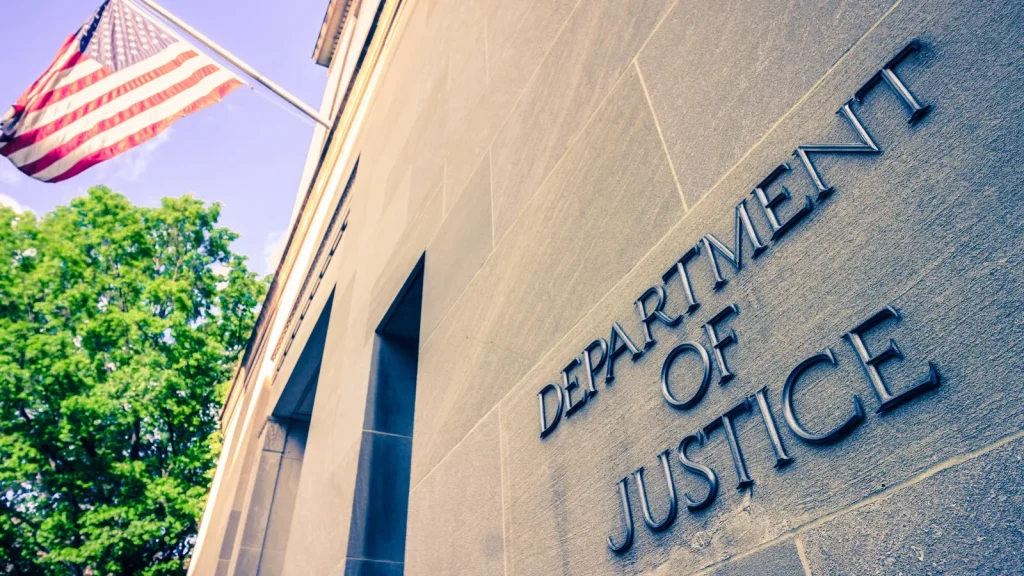In a determined move to combat international cyber fraud, the United States Department of Justice has filed a civil forfeiture complaint to recover $40,300 in cryptocurrency linked to an elaborate scam that originated from Nigeria. The scheme, which deceived a political donor into sending over $250,000 in USDT.ETH, involved impersonating a high-ranking member of the Trump-Vance Inaugural Committee.
On Wednesday, U.S. Attorney Jeanine Pirro for the District of Columbia announced the filing, emphasizing that cybercriminals had used sophisticated tactics to defraud their target. The perpetrators reportedly posed as Steve Witkoff, the co-chair of the Trump-Vance committee, and tricked the victim into believing the funds would support inaugural activities.
Scam Exploits Typographic Deception to Fool Donors
According to the DOJ’s complaint, the fraud began on December 24, 2024, when the victim received an email that appeared legitimate. The email address looked nearly identical to the official domain of the Trump-Vance committee. However, the scammers subtly altered the domain name by replacing the letter “i” with a lowercase “L,” turning @t47inaugural.com into @t47lnaugural.com. This minor change, often unnoticed due to font similarities, successfully deceived the donor.
Believing the email came from a credible source, the victim transferred $250,300 in USDT.ETH on December 26, 2024, to a crypto wallet ending in 58c52. Within two hours, the scammers dispersed the funds to several other cryptocurrency wallets in an attempt to cover their tracks.
FBI Tracks and Freezes Part of the Stolen Cryptocurrency
Despite the criminals’ efforts to launder the funds, investigators from the FBI Washington Field Office employed blockchain analysis tools to trace the stolen assets. Through this digital forensic work, agents managed to identify and freeze $40,300 of the stolen USDT.ETH.
In its complaint, the DOJ stated that this portion of the funds is now the subject of a civil forfeiture action, aimed at recovering and potentially returning the assets to the rightful owner. Although $210,000 remains unaccounted for, federal authorities continue their investigation, with hopes of identifying additional wallets and freezing more of the stolen cryptocurrency.
Officials Warn Public Against Phishing and Crypto Fraud
As part of the announcement, Steven J. Jensen, Assistant Director in Charge of the FBI’s Washington Field Office, highlighted the growing threat posed by impersonation scams. He explained that these types of cybercrimes cost Americans billions of dollars annually, especially when they involve cryptocurrency.
“Impersonation scams come in many forms, and they continue to exploit trust,” Jensen warned. “To stay safe, always double-check email addresses, website links, and spelling. Scammers often rely on very small changes to trick victims. Never send money, gift cards, or crypto to anyone you haven’t met in person or verified through trusted channels.”
Jensen further urged anyone who suspects fraud to report incidents immediately through the Internet Crime Complaint Center (IC3) at www.ic3.gov.
Larger Pattern of Crypto-Enabled Financial Crimes
This case represents one example of a much broader and troubling trend. In 2024 alone, U.S. authorities documented over $5.8 billion in losses to cryptocurrency-related scams. According to federal data, senior citizens lost a staggering $2.8 billion, making them one of the most vulnerable targets for digital financial crimes.
In a separate but related case, the Department of Justice recently pursued a $225 million crypto forfeiture involving confidence schemes that affected more than 400 victims. That action became the largest cryptocurrency seizure in the history of the U.S. Secret Service, highlighting how rapidly digital financial crime is evolving.
How Scammers Use Laundering Techniques to Evade Detection
After receiving the funds from the victim, the scammers moved quickly to hide their tracks. They divided the $250,000 across multiple wallets, using a technique known as “chain hopping”—which involves converting one cryptocurrency to another or moving assets through decentralized exchanges to make detection more difficult.
Despite these tactics, investigators succeeded in locating and freezing part of the stolen funds. Cooperation with cryptocurrency platforms, including Tether (the issuer of USDT), played a vital role in halting further transfers.
Politically Themed Cyber Scams Raise New Concerns
This scam’s use of political affiliation marks a disturbing development in phishing fraud. By exploiting the name of a high-profile committee connected to former President Donald Trump and Senator J.D. Vance, the criminals gained an air of legitimacy that helped deceive their target.
Security analysts have warned that scammers increasingly exploit current events, political campaigns, and well-known figures to make their schemes more convincing. As a result, political fundraising platforms and donors alike must remain alert and enforce stricter verification processes to avoid falling victim to similar attacks.
DOJ Reinforces Commitment to Tackling Crypto Crime
The Justice Department’s swift action in freezing and initiating the forfeiture of $40,300 sends a clear message to cybercriminals: U.S. law enforcement has the tools and determination to trace digital assets across borders and recover stolen funds.
Although the full recovery of all stolen cryptocurrency remains a challenge, the partial retrieval marks significant progress. The DOJ has confirmed that it will continue working closely with law enforcement partners, crypto exchanges, and the public to identify suspects and prevent future fraud.
Conclusion: Public Awareness and Vigilance Are Critical
This case serves as a reminder of how easily cybercriminals can exploit small details to commit large-scale fraud. Through deceptive email tactics and cryptocurrency laundering, the perpetrators managed to steal a large donation intended for a political cause. However, thanks to blockchain analysis and swift law enforcement action, part of the funds were recovered—and the scammers’ tactics were exposed.
Going forward, public vigilance, regulatory cooperation, and proactive enforcement will be key in the fight against cryptocurrency-enabled fraud. As scammers become more creative, both individuals and institutions must take steps to verify sources, secure transactions, and report suspicious activities without delay.













